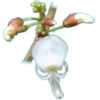Derris
Lianas. Twigs usually lenticellate. Leaves imparipinnate; stipules present, persistent or caducous; stipellae absent or present, persistent. Leaflets generally 3–9, rarely up to 15 per leaf, opposite, entire, variable in shape and size. Inflorescences axillary pseudoracemes, often combined with terminal or axillary pseudopanicles, rarely true panicles, sometimes an intermediate form present: a panicle in the lower part and a pseudoraceme in the upper part, or, a pseudoraceme in the lower part and flowers solitary in the upper part. Flowers usually 2–5 or occasionally up to 7, scattered throughout or on the top of the knob-like, club-shaped to long and slender brachyblasts. Bracts subtending brachyblasts and flowers persistent or caducous, shorter than the corresponding flower buds; bracteoles present, usually at the apex of the pedicel or at the base of the calyx. Calyx cup-shaped, often maroonish or reddish, bilabiate, upper lip 2-lobed, often indistinctly so; lower lip 3-lobed. Corolla generally whitish or pinkish; standard reflexed at base, without or with distinct basal callosities; wings approximately as long as keel petals, in some species curved backward towards the calyx, wings and keel petals adherent by lateral pockets or hooked together by auricles or twisted claws (or any combination). Stamens 10, monadelphous, with basal fenestrae; anthers all equal, fertile, glabrous or hairy. Disc generally inconspicuous or annular. Ovary with 2–5 (rarely up to 7) ovules. Pods indehiscent, thin and stiff, with a wing along both sutures or along the upper suture only, rarely wingless. Seed chambers absent but sometimes seeds surrounded by a thickening of the pod’s vascular bundles. Seeds bean-shaped, 1 or 2(–3) to rarely more per pod; hilum usually central.

Figure 1. A, majority-rule consensus tree from Bayesian analysis of all combined molecular and morphological datasets; B, majority-rule consensus tree from Bayesian analysis of the complete molecular dataset. — Numbers below branches are bootstrap support (BS) values and numbers above branches are Bayesian posterior probabilities (PP). Abbreviation of genera: A., Aganope; Au., Austrosteenisia; D., Derris; Da., Dalbergia; Deg., Deguelia; F., Fordia; K., Kunstleria; L., Lonchocarpus; Lep., Leptoderris; M., Millettia; N., Neodunnia; O., Ostryocarpus; P., Paraderris; Ph., Philenoptera; Pi., Piscidia; Pon., Pongamiopsis; S., Solori. Capital letters: “A”, Aganope clade; “D”, Derris major clade (containing also Paraderris subclade) and “DP”= the subclade containing Paraderris species [except D. (P.) laotica]; “S”, Solori clade; “ST”, Solori subclade containing tree-like species; “SL”, Solori subclade containing liana species [1].

Figure 3. Ancestral area reconstruction (AAR) of the Brachypterum (Solori) and Derris clades (Lagrange). Numbers at nodes represent node names. Grey boxes indicate reconstructions which received very low (≤ 0.1) relative probability (RP) (nodes 56, 72, 76). Black boxes represent numerous, poorly supported optimizations (nodes 43, 55 and 71). Different AAR results by S-DIVA are indicated by circles and pie charts (see Table 1). At node 68 the pie chart indicates the equal marginal probability (25%) of the area combinations BCDE, BCE, CDE and CE. B, Brachypterum (Solori) clade; BNA, New Guinea–Australian Brachypterum (Solori) subclade; BT, ‘tree habit’ Brachypterum (Solori) subclade; DI, Derris subclade 1 including Paraderris; DII, Derris subclade 2 containing the majority of Derris species sensu Geesink (1984); P, Paraderris clade nested within DI. Abbreviation of genera: B., Brachypterum (Solori) ; D., Derris; F., Fordia; M., Millettia [2].
This genus comprises about 50 species, mainly in SE Asia, one species extending from East Africa to Australia and W. Pacific (D. trifoliata Lour., a mangrove species).
Species of Derris s.s. prefer sunlight and water, and are, therefore, usually found in fully exposed or semi-shaded areas along streams or rivers, sometimes in mixed deciduous forests or at the edge of dry evergreen forests, also found in disturbed or degraded areas; D. trifoliata is typical for the mangrove; while D. tonkinensis and D. solorioides only occurs on limestone.
